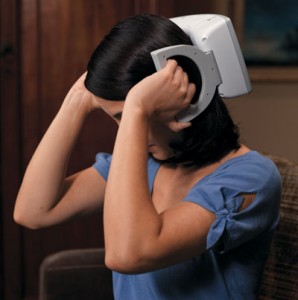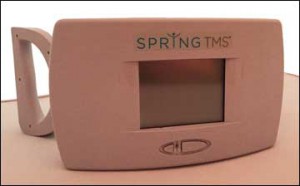 Note (10/27/20): eNeura, the company that makes SpringTMS and sTMSmini, filed for bankruptcy in August 2020. The devices are not currently available to patients.
Note (10/27/20): eNeura, the company that makes SpringTMS and sTMSmini, filed for bankruptcy in August 2020. The devices are not currently available to patients.
A non-drug treatment with few reported side effects that works as both an acute treatment for migraine attacks and a migraine preventive. That describes the Spring TMS, which received FDA approval in 2014 and is slowly becoming available throughout the country. Compared to other technologies, Spring TMS’s rollout has lacked much fanfare, but it’s a pretty exciting treatment with a long history of research to support its use.
Transcranial magnetic stimulation (that’s what TMS stands for) uses a very short magnetic field to send a brief energy pulse through the skull into brain tissue. The pulse causes very mild electrical currents in the brain that are believed to stop a migraine attack by interrupting the abnormal electrical activity in the brain caused by migraine.
My experience with Spring TMS might make you wary. I believe the worsening of my migraine attacks while using it was coincidental, not caused by the device itself. I still advocate for trying it because the research on Spring TMS is quite strong. I also advocate for talking to your doctor about what to do if your head pain worsens while using the device.
Here’s what you need to know for getting a Spring TMS, from which doctors can prescribe it and learning how to use it to its cost and how the rental program works. It contains an exact transcript of the questions an eNeura executive answered for me in April.
Kerrie: Can any doctor prescribe Spring TMS? If not, how can a patient choose a doctor to prescribe it?
eNeura: The device is currently available by prescription in specialist headache centers around the US. If you want to see which doctors near you can prescribe the Spring TMS email customercare@eNeura.com or call 1(408) 245-6400, and press 1 to speak with a Customer Care representative. Doctors who are interested in prescribing the device can also email or call eNeura customer care.
How much does it cost?
Spring TMS is available by prescription under a rental program. The cost is comparable to other prescribed migraine treatments. The company offers a $300 discount off the first 3 months for new patients. A new 3 month prescription is $450 ($150 per month) plus a one time $50 shipping charge. Total charges for the first three-month period come to $500.
[The above pricing only applies for the first three months of use. Here’s updated pricing information from eNeura’s customer service department, current as of Aug. 24, 2016: We rent the device in 3-month increments. At list price, the cost per month is $250. A patient who selects the 12-month option will average $175 per month for SpringTMS. We also offer new patients a $300 discount on their first prescription, which would bring the cost per month down from $250 to $150 for that first prescription.]
Does insurance cover SpringTMS?
As a new migraine treatment, insurance coverage for Spring TMS varies and will likely require documentation of medical necessity from the prescribing physician. eNeura has retained an insurance reimbursement consulting service for patients wishing to pursue insurance coverage. eNeura Customer care will help you get started. Call 1(408) 245-6400, and press 1 to speak with a Customer Care representative.
Do you bill insurance? If not, have patients been successful applying for reimbursement from insurance companies?
eNeura does not bill insurance companies, but patient’s can submit invoices to their insurance company for potential reimbursement.
How does the rental program work?/How does a patient renew a prescription?
eNeura: Near the end of the three-month period, the patient’s doctor can send a renewal prescription to eNeura. eNeura, in turn, emails an invoice for the renewal period. Once that’s paid they will mail a new SIM card to replace the original SIM card in the machine. If the prescription is not renewed and the new data card is not inserted in the Spring TMS unit, it stops working.
Is special training required to learn how to use the device?
It is easy to use and is fully automated to guide the patient through treatment in a step-by-step fashion. While there is no special training required, eNeura offers an individualized program to support you as you begin using the Spring TMS.
A Clinical Education Consultant will contact you when your Spring TMS arrives to help you get started and answer your questions. During your first 3-4 months of use, your nurse will continue to support you in your treatment plan, answer your questions, review your diary and report your progress to your doctor.
Is the unit shipped directly to the patient or does it go through the doctor?
Prescribing doctors send the three-month prescription to eNeura. Once the prescription is received, eNeura prepares the device and ships it directly to the patient’s home.
If a patient stops using the device, how do they return it?
When a patient receives their SpringTMS in the mail they are instructed to keep the original packaging. If a patient stops using the device, it needs to be shipped back to eNeura. Contact eNeura Customer Care to obtain a prepaid return shipping label. There is no charge for returning the device.
What else would you like patients to know about SpringTMS?
Many migraine patients are looking for non-drug treatment options. For them medications either don’t work… may be contraindicated or just not well tolerated. SpringTMS offers a safe clinically proven treatment option without medication side effects.
Longtime reader Timothy Bauer checked in with eNeura on July 20 after reading my article on Migraine.com. He was told that doctors who have not already been trained in prescribing the device may have to wait several months for training. The company gave him the names of doctors in his area who have already been trained.

 Note (10/27/20): eNeura, the company that makes SpringTMS and sTMSmini, filed for bankruptcy in August 2020. The devices are not currently available to patients.
Note (10/27/20): eNeura, the company that makes SpringTMS and sTMSmini, filed for bankruptcy in August 2020. The devices are not currently available to patients.